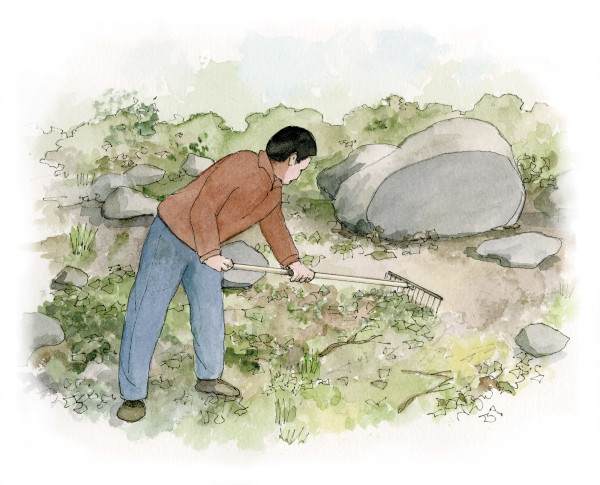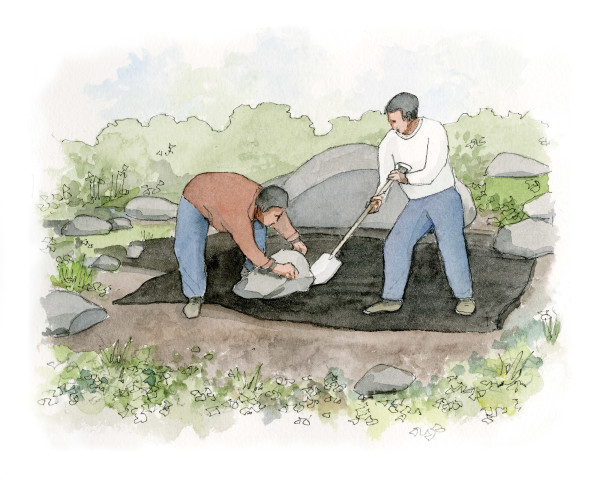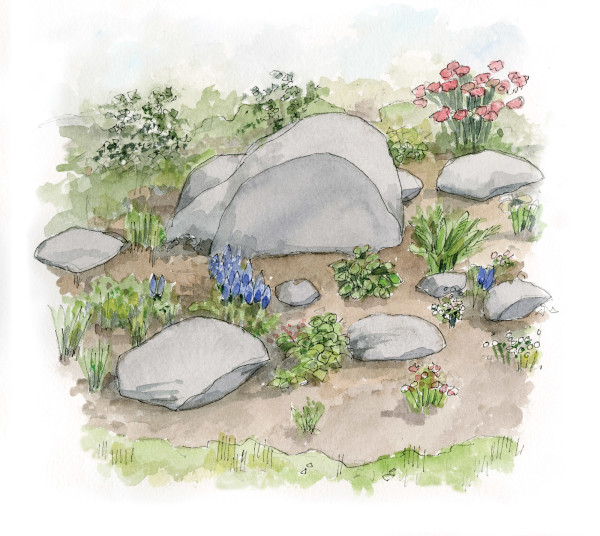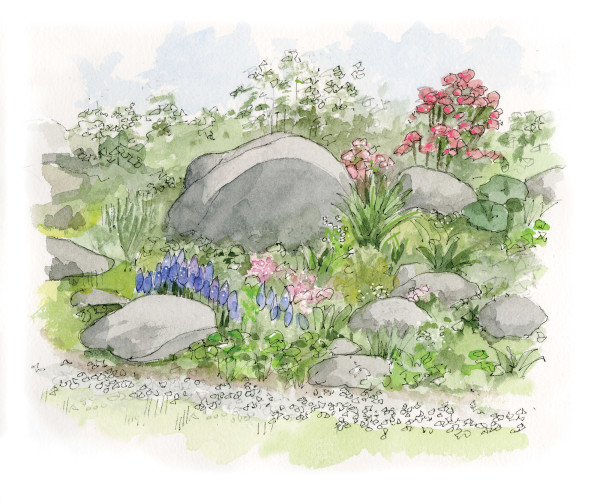Making the best of a sloped yard—or adding interest to a flat one—rock gardens also require less maintenance than a lawn or flower border. Difficult areas become pretty or dramatic focal points, all while demanding less water and no mowing.
Your first task is to map the site. Make a note of any access covers for pipes, marking them with a dowel or a small flag. You’ll have to work around those areas as the rock garden is laid out, to keep them accessible. If your yard already has boulders or stones, try to incorporate them into the plan rather than moving them, or importing rocks.
Clear this site of grass, roots, and any unwanted elements and debris. Rob Leanna
STEP 1
With a garden spade, mark the boundaries of what will be your rock garden. Clear this site of grass, roots, and any unwanted elements and debris. To inhibit the growth of weeds before the plants fill the space, place a layer of biodegradable weed barrier or multiple layers of newspaper over the dug-out area. A rock garden should be slightly sloped when it’s laid; you can use small rocks under the topsoil to create terracing. If your garden isn’t naturally rocky, consider what type of stones you want to import. See “Rock Options” (opposite page) for ideas.
A well-drained, sunny scree garden can host Mediterranean plants, small succulents, etc. Rob Leanna
STEP 2
Sometimes it’s helpful to sketch the rocks’ placement first, and then move the rocks. They should have a random arrangement to give the garden a natural look. Try rocks grouped in twos and threes.
Also plan for a transitional area between the rock garden and the lawn, walk, or driveway. By using gravel, you can plant a low-maintenance scree garden in this space. (A scree bed mimics natural scree—ground where rocks near the surface have shattered to become a stony debris field. A well-drained, sunny scree garden can host Mediterranean plants, small succulents, etc. Let the scree follow natural contours; it shouldn’t be too level. Use at least a 3″ depth of pea gravel.)
After planning, start placing the stones. Position boulders or large rocks first because they are the focal points. They may need to be supported with bricks or smaller stones underneath. Use safe lifting practices and know your limits—this is laborious work. Use a hand truck or a dolly to roll stones into place, and a shovel or a crowbar to adjust their position. Have an assistant help.
Next come the medium-sized rocks. Play with sizes and shapes; for example, you might pair a large boulder with a smaller one or a smooth rock with a sharper one. Partially submerge some or most of the stones for a natural look. At this point, spread topsoil (before adding the smallest rocks). The topsoil laid over the weed-resistant layer should have good drainage: Mix two parts fresh, weed-free topsoil with one part of a material such as gravel, lava rock, or sand. Tamp down the soil and water with a garden hose. Let it settle for two days before planting.
Limit the number of different types of plants you use, which is more natural and pleasing to the eye. Rob Leanna
STEP 3
Now you’ll place plants next to rocks or in crevices between rocks. Choose plants for sun, part shade, or shade, depending on the specific conditions of your garden. As you place the plants, cover any bare areas with smaller stones. Because the site is sloped, start at the bottom of the site and work upwards.
Limit the number of different types of plants you use, which is more natural and pleasing to the eye. Don’t cover the garden completely with plants—the rocks should be visible. Leave enough space between plants so that they can spread out as they grow. Consider the ultimate height of plants for both their placement and the scale of the garden. You may not want plants that protrude too high above the rocks, or you may want a mix of low and taller.
Consider color, too. Granite grey looks good with colors from cool blues to warm pinks and bright white. Sandstone, however, may look better with plants limited to a warm palette. Finally, fill your scree bed with gravel, pea gravel, or a combination of small-scale materials. It’s optional, but if you have full sun, you may also want to plant alpines and groundcovers in the scree.
Porous rocks such as sandstone or hard limestone add a weathered look—and are easy to split if necessary. Rob Leanna
Rock Options
Because moving stones is so labor intensive, you’ll want to use rocks from the site—or at least from close by, to save on transport. If you are bringing stones in, put some thought into your choice. Porous rocks such as sandstone or hard limestone add a weathered look—and are easy to split if necessary. Craggy tufa (soft limestone) provides nooks for plants to grow in, but may break down eventually. Hard granite won’t have the same character, but its jagged forms add drama. Smooth boulders and river rock also have soft edges. Moss- or lichen-covered stone adds to a naturalistic, unplanned look.
Gravel—crushed stone—ranges in size from 2″ to 4″ to pebbles ¾” or smaller. Some sizes come polished, but unpolished has a more native aesthetic. Use a mix of sizes under plants and between boulders. Take into account your regional rock types. To order, know the square footage of coverage as well as how many inches deep the gravel bed will be.
Rock Stars: which plants thrive
Stones retain heat, and so rock gardens can be too dry for some plants, so opt for heat-loving ones. Ranging from tiny specimens to cascading plants to grasses, alpine plants are a rock-garden favorite. Cascading plants such as dwarf aster, candytuft, alyssum, sedum, rock cress, and snow-in-summer are a must because they’ll spill over hard edges, softening the look. Specimens such as creeping thyme, soapwort, creeping phlox, and blue star creeper spread out, providing groundcover.
To avoid a garden that is bare in the winter, choose some evergreens such as Cole’s prostrate (a type of hemlock), dwarf cotoneaster, and dwarf mountain pine. For spring color, incorporate a variety of bulbs such as crocus, miniature daffodils, freesia, grape hyacinths, dwarf iris, and snowdrops.
Low-growing trees such as dwarf conifers and acer (Japanese maple) may add just the right amount of verticality to a ground-hugging rock garden. Herbs work well, too—try catmint, thyme, or verbena. Little Bunny dwarf fountain grass, blue creeping sedge, Japanese forest grass, blue oat grass, and blue fescue have fluffy plumes and whispy strands to create year-round impact. Alpine plants aren’t the only option. In the right climate, succulents such as hens-and-chicks, blue chalk sticks, Eche-veria glauca, agave, and many cacti are visually arresting.







